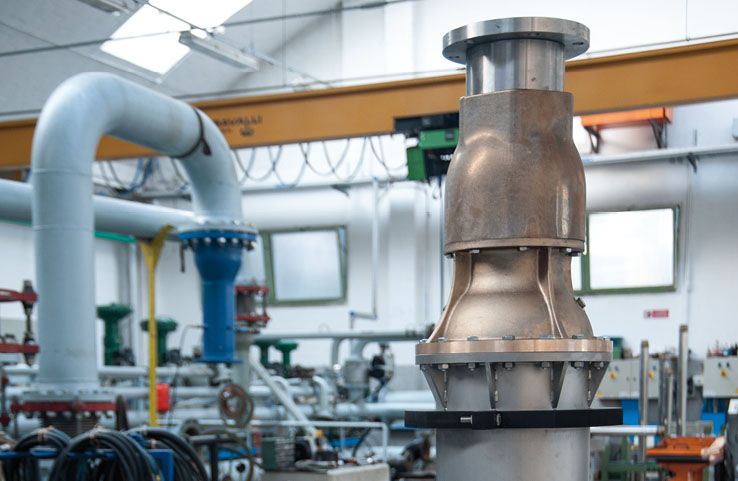BOREHOLE PUMPS
Borehole pumps are pumping systems that pump water up from deep underground wells for use in irrigation, drinking water and industrial applications. They are powerful, efficient and durable.
Our customers rate us 8,6  based on 136 reviews
based on 136 reviews
operation, applications and maintenance
Borehole pumps: Everything you want to know
The operating principle of borehole pumps is the same as that of a submersible or centrifugal pump. The pump consists of an impeller housing and pump motor that is electrically powered.
The big difference is in the design: a borehole pump is elongated with the pump housing and motor in one line. The reason is as simple as it is effective: the pump is placed in a well and since the diameter of the well is determined by the pump, it is important to keep it as small as possible. By keeping the diameter limited, the costs of producing the source will also be lower.
The range is large and can be tailored to specific customer requirements and can vary from 3" to 48", with the 4" to 18" range being the most sold.
HOW DO YOU SELECT BOREHOLE PUMPS?
Of course, an expert from IPG will be happy to help you select the right well pump for your application. You can always contact us without obligation or request a quote. We will base the selection on the points below, among other things, so keep in mind that this information must be known whether we can arrive at this information together during a telephone conversation without obligation.
How big is the source? What is the diameter? The pump will have to fit in here.
Depth of the source:
It is not entirely unimportant to know how deep the water is in the well, what is the water level? A well pump cannot withstand running dry and it is therefore important that there is always sufficient water supply for the pump in the well.
Head of the pump:
It is important to know from how deep the water should be pumped, but also how much pressure is required to pump the medium further. This head can often be calculated when you know more about the location where the medium is needed or the piping system.
Capacity of the pump:
How many liters /cubic meter is required per second, minute, hour? What should the pump deliver in number of medium. This question is often asked together with the head of the pump and is also referred to as the flow rate of the pump.

Outstanding and accessible customer support at every touch point!
Deployment is perfect and very service-oriented. Both by phone, during planned realisation and unplanned breakdowns.
Project leader RGR at waste contractor in the Netherlands.
Rating: ⭐⭐⭐⭐ 4/5
Excellent experience with IPG: professionalism, quality and proactive problem solving!
As a work planner, I experience IPG as very professional. They strive for quality, think about improvements and fix breakdowns quickly to minimize downtime.
Work Planner at a water authority.
Rating: ⭐⭐⭐⭐⭐ 5/5
A reliable partner with outstanding service and customer-oriented advice!
I experience IPG as a very good partner, a company that values service, and thinks and advises with the customers.
Technical Service Work Planner at waste management company in the Netherlands.
Rating: ⭐⭐⭐⭐⭐ 5/5
ADVICE AND SALES
THE BEST POSSIBLE SOLUTION FOR YOUR APPLICATION
There are many different types of pumps and just as many applications, such as a submersible, circulation or well pump. Due to this diversity of pumps, it is wise to be well informed about what type of pump is required before you purchase one or have it overhauled. The IPG team with various pump experts can always advise you on the best possible solution for your application and can also support you with the purchase and installation of the pump.
IPG has strong relationships with various pump manufacturers and can therefore give you good advice in purchasing many types and brands of pumps. For example, the Industrial Pump Group is the Dutch importer of SAER and official dealer of Lowara, Grundfos and Seepex, among others.
BOREHOLE PUMPS
Many brands available
The Industrial Pump Group supplies a wide range of bore hole pumps from renowned brands such as SAER, Lowara and Grundfos. The pumps are suitable for a well diameter of at least 4 inches to virtually unlimited. These high-quality borehole pumps distinguish themselves in the market by their high efficiency (energy-efficient) and durability (long service life). Impellers and circulation covers have been developed in accordance with the latest technology, whereby all turbulent flow (= efficiency loss) has been excluded. As a result, with our borehole pumps range you achieve the lowest possible energy consumption and therefore the highest efficiency.
Also, due to the lack of turbulent flow in the borehole pump, we can guarantee very long service life and an amount of sand / soil present is not necessarily harmful to the pump.
SAER Elletropompe S.p.A.
Active as a pump manufacturer since 1951, SAER (bron) develops and produces pumps and motors in its own factories in Italy. Extensive material options such as Nickel Aluminum Bronze, Duplex and SuperDuplex are available from stock in addition to the standard alloys cast iron, Marine Bronze and AISI 304 and 316, resulting in a short to very short production lead time.
Xylem Lowara
The Xylem product range consists of a wide range of deep drawn stainless steel 304, cast stainless steel 316 and Duplex borehole pumps. A distinctive design feature is the “dynamic” wear ring which minimizes hydraulic losses and protects the pump from blocking during stand-by periods. In addition to the borehole pumps, a derivative variant is also available: the vertical turbine pump.
Grundfos
The Grundfos submersible pumps are known for their high efficiency and reliability throughout the range. The pumps, made entirely of corrosion-resistant stainless steel, are ideal for a wide range of applications. Grundfos pumps represent state-of-the-art hydraulic design. Built for optimum efficiency during periods of high demand, the SP pumps offer low long-term costs and high reliability, whatever the application.
Ebara
The Italian Ebara also produces borehole pumps, many already 3″ and 4″ and in stainless steel. These pumps are extremely suitable for garden irrigation, pressure installations and fire fighting. Popular series of borehole pumps from this brand are the SB and Winner series. Both series are equipped with a standardized NEMA motor.
The motor
Technical performance
The submersible motor is an asynchronous motor composed of the pump parts stator, rotor and bearings. Since the motor is continuously submerged, the design differs from a standard norm motor. Both the special pressure-loaded bearings and the use of a mechanical seal in the motor deviate from a standard motor. The motor can be hermetically sealed - cooled by the surrounding medium or can be rewound in the market called rewindable or wet motor.
Due to the installation under water, no ventilation can be applied. The motors are therefore liquid filled with water or oil. It is important to take into account the fact that a minimum flow rate must be created around the motor in order to guarantee the cooling of the motor.
To optimize this, the pump and source diameter must be matched. If the pump is installed horizontally, a cooling shroud can be used to achieve the required flow rate past the motor.
When the pump is started, the liquid in the pump starts to rotate with the impeller. The liquid experiences the action of the centrifugal force. It therefore flows into the pump housing at the outer circumference of the impeller and then, via the discharge opening, to the discharge pipe. However, these pumps cannot run dry (pumps without liquid), which are the advantages of a centrifugal pump, which you can read at the bottom of the page.
The pump part
Borehole pumps are modular in construction. The pump parts are made of cast iron or deep-drawn stainless steel. The casting can be carried out in different material specifications for an optimal result. The pump parts are available in cast iron, deep-drawn stainless steel 304/316, cast stainless steel 316, zinc-free bronze, Nickel Aluminum Bronze, Duplex and SuperDuplex.
Impellers are dynamically balanced to minimize vibration. The pump shaft runs in high-quality radial bearings that are lubricated by water. All parts subject to wear, such as wear rings, shaft and bearing bushes, are easy to replace. The pumps are fitted as standard with a non-return valve, which is available in various versions.
Borehole pump applications
The submersible pumps are used for irrigation purposes in agriculture and horticulture, sprinkler systems and for various industrial applications. The pumps are also used in mining, on dredgers and as ballast pumps on ships and floating platforms in the on/offshore industry. Each application has a specific approach: for the pumping of seawater in an offshore application you have to deal with a wide variety of types of corrosion / oxidation by the seawater. For this we use the material SuperDuplex (DIN 1.4517), Marine Bronze or Nickel Aluminum Bronze.
Borehole pump parts
The Industrial Pump Group supplies various parts for the larger well pumps from SAER, Grundfos and Lowara, among others. You have come to the right place at IPG for O-rings, seals, gaskets or even complete pump parts. You can always request a free quote for parts requests.


